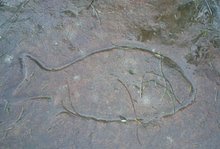 Whales are passing by. Today two Humpback Whales (Megaptera novaeangliae) swam slowly along Manly Beach. It appeared like mother and calf logging, in close contact. After Shelly Beach they slowly drifted along the shore in the shallow water. Their habitat was free of polluting motors in the air and in the ocean, which is rare.
Whales are passing by. Today two Humpback Whales (Megaptera novaeangliae) swam slowly along Manly Beach. It appeared like mother and calf logging, in close contact. After Shelly Beach they slowly drifted along the shore in the shallow water. Their habitat was free of polluting motors in the air and in the ocean, which is rare. A bit further north in a more protected terrestial area, there are rock engravings by the Eora of a Humpback mother and her calf. The 14 m long petrography depicts them overlapping in close body contact. An engraved person nearby is watching with views of the Pacific. Today the aquatic territory is littered in motorboats. Like measles they clutter up the shorelines. Noise and chemical pollution emanating from their presence interferes today with the large marine mammals pursuing their ancient migratory routes.
A bit further north in a more protected terrestial area, there are rock engravings by the Eora of a Humpback mother and her calf. The 14 m long petrography depicts them overlapping in close body contact. An engraved person nearby is watching with views of the Pacific. Today the aquatic territory is littered in motorboats. Like measles they clutter up the shorelines. Noise and chemical pollution emanating from their presence interferes today with the large marine mammals pursuing their ancient migratory routes. The place is framed by the Eora shield, lovers and various symbols etched onto the sandstone.
The place is framed by the Eora shield, lovers and various symbols etched onto the sandstone.
With the unregulated access of mountain bikes these memes from 25000 years ago could disappear from the rocks and human memory. The whales too have to battle a degraded habitat with many human-made dangers.
More on whales and bikes in NPs.
10 August 2009
Humpback Whales Passing Manly Beach
19 August 2007
The Waratah - Gondwana plant and Wonga pigeon
 The Proteaceae (images, DB) emerged 118 million years on Gondwanaland. The Australian variety developed 40 milion years ago when the continent separated from Africa. This is the time of the emergence of the Australian Waratah. The local Eora people gave the plant its name. The New South Wales Waratah (Telopea speciosissima) is the emblem of NSW today. It is extremely rare in gardens, but there are still pockets in National Parks, provided they do not get 'harvested' for their spectacular large and red flowers. Depicted in woodcuts of Margaret Preston, they finds their purpose today in the floral industry.
The Proteaceae (images, DB) emerged 118 million years on Gondwanaland. The Australian variety developed 40 milion years ago when the continent separated from Africa. This is the time of the emergence of the Australian Waratah. The local Eora people gave the plant its name. The New South Wales Waratah (Telopea speciosissima) is the emblem of NSW today. It is extremely rare in gardens, but there are still pockets in National Parks, provided they do not get 'harvested' for their spectacular large and red flowers. Depicted in woodcuts of Margaret Preston, they finds their purpose today in the floral industry.
In The Stories of the Dreaming, Barry Moore shares the 'Red Waratah' (also as rich media). A central player in the story is the Wonga pigeon, now rare as they used to shoot this pigeon in the 40's and land clearing reduced its habitat drastically. Both Waratah and Wonga might have co-existed in the Manly region once. Some of the Gondwana plants are still with us in the region (pdf).
Both Waratah and Wonga might have co-existed in the Manly region once. Some of the Gondwana plants are still with us in the region (pdf).
Images: top, part of "Skygarden"
bottom, Strand Arcade window










